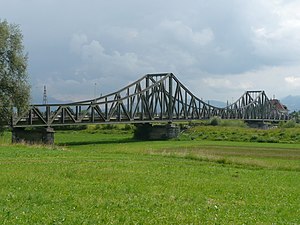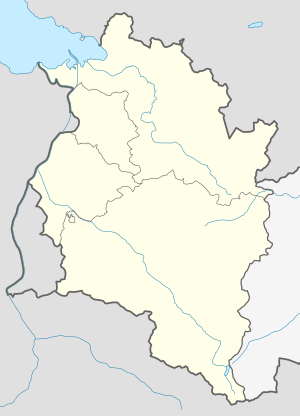Wiesenrain Bridge
Coordinates: 47 ° 24 ′ 32 ″ N , 9 ° 39 ′ 6 ″ E
| Wiesenrain Bridge | ||
|---|---|---|
| Wiesenrainbrücke as seen from Widnau (near Rheinstrasse). | ||
| use | Transport cars, lorries and official railways of the International Rhine Regulation, pedestrians, cyclists | |
| Convicted | Alpine Rhine | |
| place | Lustenau and Widnau | |
| construction | steel | |
| overall length | about 260 m | |
| width | about 10 m | |
| Load capacity | 16 tons | |
| completion | 1914 | |
| opening | May 25, 1914 | |
| location | ||
|
|
||
| Above sea level | 410 m above sea level A. | |
The Wiesenrain bridge (also Rhine bridge or New Widnau bridge , 410 m above sea level. A. ) in Lustenau , Wiesenrain or Widnau is in Austria listed ( list entry ) steel bridge over the Alpenrhein leads.
Motor vehicle traffic, pedestrian and bicycle traffic as well as the international Rhine regulation service line cross the bridge on the same lane . It is only used to a limited extent for the transport of goods on the International Rhine Regulation service. The passage with trucks is limited to vehicles up to 16 tons.
Surname
The bridge is simply referred to as the Rhine bridge or, with reference to the Wiesenrain district of Lustenau, today it is mainly called the Wiesenrain bridge . Formerly also called Neue Widnauer Brücke .
history
In 1870 a Rhine ferry to Lustenau was set up near Widnau. This was replaced in 1875 by a covered wooden bridge, which in turn was replaced in 1914 by the steel truss bridge with a customs station that still exists today.
The covered wooden bridge built in 1875 was built at the expense of the community of Widnau a little south of today's steel bridge as a non-public wooden bridge in order to be able to more easily manage the agricultural land of the Widnau farmers (so-called "Swiss Rieder" in the southern part of Lustenau) in Austria. This "private bridge" of the Swiss farmers was not permitted for public border traffic. The Austrian tax authorities did not want an additional customs office on Wiesenrain. The other two Rhine bridges in the municipal area of Lustenau, the upper drive bridge and the lower drive bridge, should not have any additional competition. This bridge was demolished in 1912 as part of the work to regulate the Rhine .
The previous covered wooden bridge (later referred to as the Alte Widnauer Brücke ) was split into four parts and became the Nöllenbrücke in Widnau, which still exists today, and the Senderbrücke ( Dornbirn / Lauterach ). Two other parts of this Rhine bridge were used as local bridges and led to the Widnau part of the Swiss Ried in Lustenau (these two bridges burned down).
The approximately 260 meter long bridge ( 410 m above sea level ) built by 1914 leads in turn from Widnau in Switzerland to Lustenau in Austria . The road over the bridge leads from the east (from Lustenau) over the Philipp-Krapf-Straße (L44) over the Swiss / Austrian border in the middle of the Alpine Rhine to the west to Rheinstrasse (in Widnau). Like its predecessor ( covered wooden bridge ), the bridge was built primarily for transport purposes across the Alpine Rhine. Public transport has been possible over this bridge since 1914.
The opening took place on 25 May 1914 the speech was from the National Ernst Schmidheiny I. held.
Web links
- 11 - Neue Widnauer Brücke , website of the market town of Lustenau.
Individual evidence
- ^ Markus Kaiser: Widnau. In: Historical Lexicon of Switzerland . November 11, 2014 , accessed July 8, 2019 .
- ↑ 12 - Alte Widnauer Brücke , website of the market town of Lustenau.
- ↑ According to the information board of the community of Widnau near the Nöllenbrücke.
- ↑ Susi Miara: New bridge based on the old model , Tagblatt.ch of June 29, 2012.
- ↑ Otto Frei, Dr. Benedikt Fehr, Hans Fehr: Widnau - past and present . Ed .: Political community Widnau, local community Widnau. Rheintaler Druckerei und Verlag AG, Heerbrugg 1982, The fight for an own iron bridge, p. 136-140 .


